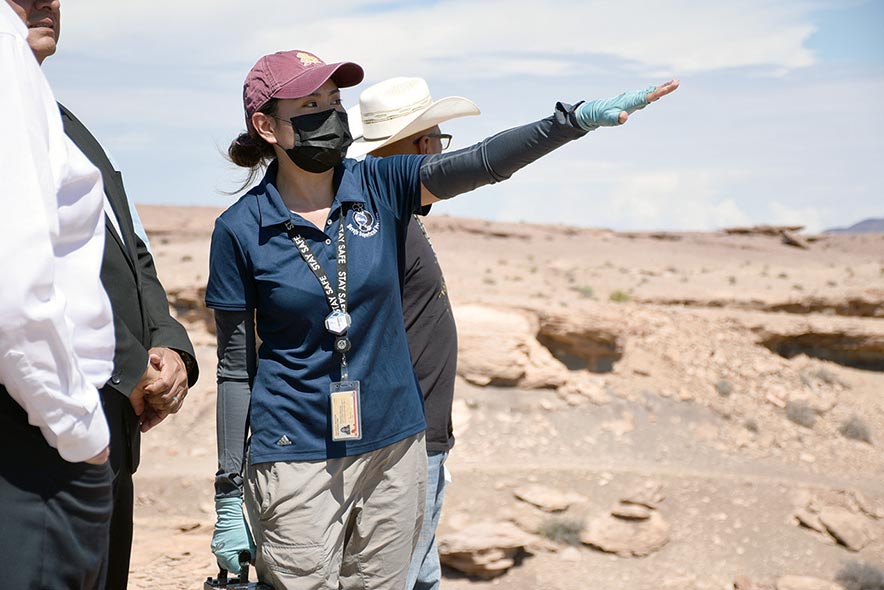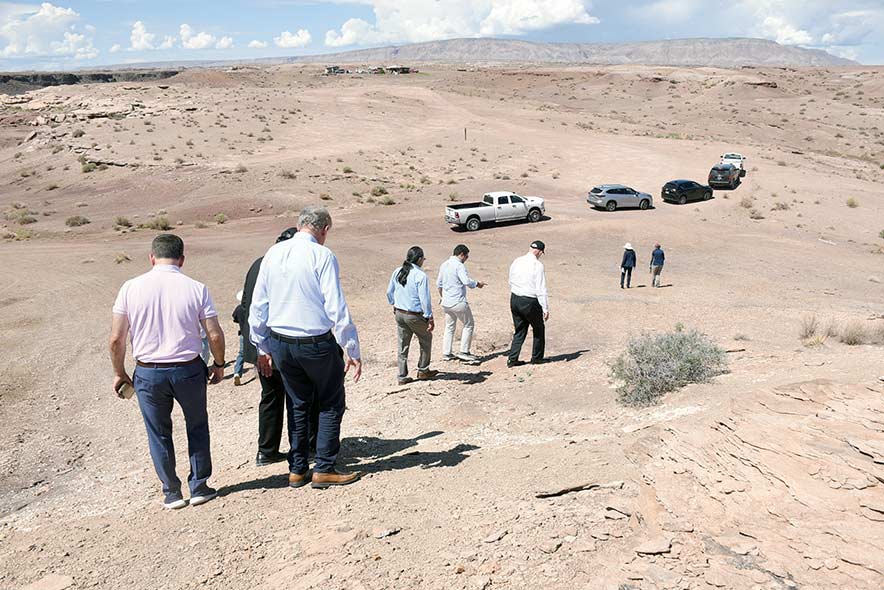
Grand Canyon gateway chapter wants uranium cleanup

Navajo Times | Krista Allen
Shelby Dayzie of the Navajo Environmental Protection Agency points out the numerous abandoned uranium mines in Cameron, Ariz., last Thursday morning.
TSÉBIGHÁHOODZÁNÍ
Some of the children in Na’ní’á Hasání have no choice but to play next to uranium mines.
Their parents also grew up next to mines and played in contaminated water.
Livestock grazes on the land.
And some families built their homes out of radioactive mine tailings.
Na’ní’á Hasání leaders say they need a strategic plan for uranium cleanup and to focus on environmental remediation.
Alicia Chee, Delegate Thomas Walker Jr.’s legislative district assistant who grew up in Na’ní’á Hasání, said she’s concerned about the children who are playing in mine debris piles.
“We want playgrounds for them, so they don’t play in uranium sites that don’t have a sign,” Chee said. “The sites are not fenced off.
“(Early in) this pandemic, we had virtual learning, and we had a lot of kids stay at home,” she said. “Their playground is the terrain. What are we exposing our kids to? Culturally, we’re supposed to embrace the land – we’ve been doing that.
“We already know what the exposure is,” she said, “from our previous generation, and we’re seeing what (they’re) living with.”
Toxic legacy
Abandoned uranium mines are found in all corners of the Southwest, and about 524 dot Diné Bikéyah.
But there could be far more, according to the Navajo Nation Environmental Protection Agency.
Mines near Bidáá Ha’azt’i and Na’ní’á Hasání have left a toxic legacy.
Shelby Dayzie, for the NNEPA, said 111 are in Western Navajo alone, leaving some residents devastated by organ cancers and other illnesses.
Dayzie said the northern and eastern parts of the Navajo Nation come behind western.
“Northern has a significant (number) of mines, and eastern has problematic mines (because) they did a lot of underground mining and they (residents) have a lot of issues with their water,” Dayzie said in an interview.
“Northern is harder to access because they did a lot of cliff mining,” she said, “and those are (more complex) areas to access because of safety reasons.
“And that’s another thing a responsible party will argue that there is no access to that mine, so it poses no threat,” she said. “Because no one can access it, it means we’re good to go. But we’re really concerned about what’s underneath. How badly is it contaminating the soil?”
Blessing, curse
In 2012, the Obama administration passed a 20-year moratorium on new uranium mining on one million acres near Bidáá Ha’azt’i.
Private and foreign mining companies are fighting to have it overturned.
Na’ní’á Hasání Chapter Vice President Candis Yazzie said it’s a blessing and a curse to live in the gateway communities of Na’ní’á Hasání and Dził Łibéí because these areas are beautiful yet arid.
Last Thursday Yazzie told tribal, and state lawmakers – including President Jonathan Nez, Congressman Tom O’Halleran, D-Ariz., and U.S. Rep. Frank Pallone Jr. , D-N.J., chair on the House Energy and Commerce Committee – what brought them to Na’ní’á Hasání is the issues in the community.
“We’re working on getting more direct resources our community has been asking about,” Yazzie said. “In this case, (radiation detection instruments) so we can walk on the land. We don’t know where the (radiation) is, and we need to identify that area and plan for our community accordingly.”
Chee said Na’ní’á Hasání might be a gateway community, but it’s an overlooked community at the local level where residents are demanding services, development and housing.
“We want to be an area where it’s safe for the long-term,” Chee added.
Abandoned sites tour

Navajo Times | Krista Allen
Tribal and state leaders, including President Jonathan Nez and U.S. congressmen Frank Pallone Jr. and Tom O’Halleran, tour abandoned uranium sites near the Little Colorado River in Cameron, Ariz., on Aug. 18.
Dayzie last Thursday led leaders through at least four abandoned uranium mines areas – A & B No. 3, Yazzie No. 312, Lemuel Littleman No. 3, and Charles Huskon No. 14.
Uranium ore deposits in the Na’ní’á Hasání and the Dził Łibéí areas have been mined from sandstone lenses in the Shinarump and Petrified Forest members of the Upper Triassic Chinle Formation and the Lower Jurassic Formation, according to the Arizona Geological Survey.
In the Kayenta Formation on Ward Terrace, uranium was first reported in these areas in 1950.
At that time, the U.S. Atomic Energy Commission employed Diné to prospect the entire area.
Charles Huskon, an AEC prospector, made the first discovery of commercial importance in June 1952.
And production from the Kayenta Formation began on Hosteen Nez’s homestead in August 1951, and production peaked in 1956 and declined until the last shipment in January 1963.
More than 289,000 tons of ore, averaging 0.21% triuranium octoxide and containing 1.2 million pounds of the element, was produced from 100 separate sites, according to history.
The president said cleanup efforts are in progress, but more needs to happen to fully fund the actions of the remaining (unaddressed) uranium mine sites.
“We have so many Navajo people who are challenged with health issues directly caused by uranium mining activities conducted by the federal government,” Nez said.








 Highway 264,
Highway 264, I-40, WB @ Winslow
I-40, WB @ Winslow